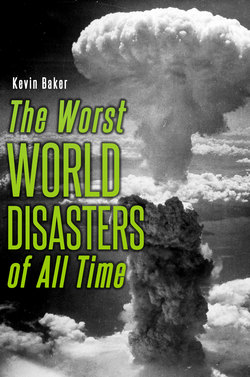Читать книгу The Worst World Disasters of All Time - Kevin Baker - Страница 18
16 – Hindenburg Disaster
ОглавлениеThe Hindenberg going up in flames.
Date: 6th May 1937.
Location: Lakehurst Naval Air Station, New Jersey.
Disaster Type: Fire.
Fatalities: 36 deaths.
Resulting Damage: German passenger airship destroyed.
Just like any new technology, it took some time for flying to become what we now know today. In the early 20th century, people had not experienced large scale air disasters, and so far most airplanes were small vehicles that carried only a few people. But as demand grew for air travel, so did vehicles to carry them. Soon, large airships were constructed to carry passengers over large distances, but very little was done to ensure adequate safety measures. In fact, in order to make them easier to fly, these early airships were filled with hydrogen, making them a real bomb waiting to go off. It wasn't until the Hindenburg disaster that people realized how dangerous that could be.
The Hindenburg was a German made airship which left for its first commercial trip to the US in May of 1937. After running for a year between Germany and Brazil, it was to now start round-trips between Frankfurt and New York City. It lifted off on May 3rd and took three days to cross the ocean. It headed towards Lakehurst where it was set to land with passengers then taking connecting flights. However, bad weather forced the airship to make a detour, and the captain went over Manhattan and part of New Jersey while waiting for the storms to subside.
The Hindenburg headed back to Lakehurst at around 7 PM after the weather cleared and was set to be attached to the Naval Air Station, a high tower where mooring cables would be dropped and the ship winched down. It took 25 minutes for the Hindenburg to position itself, including releasing enough ballast to get to the right altitude. Only once it was ready to land did the first signs of trouble appear. Blue flames could be seen along the fabric of the ship, and the airship then suddenly caught fire. The fire quickly engulfed the entire ship which came crashing down into the landing bow and then into the ground. Because airships of this size were relatively new, several news cameras were there and filmed most of the event.
Out of the 36 passengers and 61 crewmen, 13 passengers and 22 crewmen died as well as a ground crewman. A few people managed to escape the huge inferno because the ship was already low in the sky, and sometimes by pure luck. Many escaped with burns and were sent to a local hospital.
The exact cause of the disaster was never discovered, but several theories were shown to be likely. The first suspect was sabotage, as in that time it was fairly common with political tensions. However, no evidence was found pointing this way. The other possible cause was static discharge. While there is no way to confirm whether this was the true cause, witness accounts saying they saw blue flames dancing along the fabric which supports this theory. Finally, some think that because of the bad weather and sharp turns the airship had to make, one of the engines may have failed and emitted a flame towards the fabric of the ship. Regardless of the initial cause, the design of the ship and the use of hydrogen were responsible for the fire engulfing the vessel so quickly. After the Hindenburg, future airships were redesigned to be much less susceptible to this type of accident.
